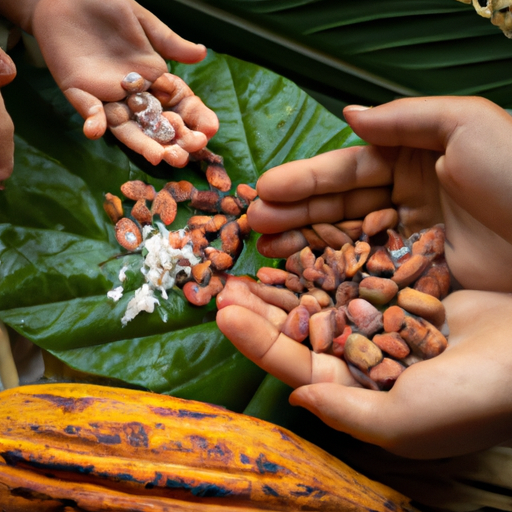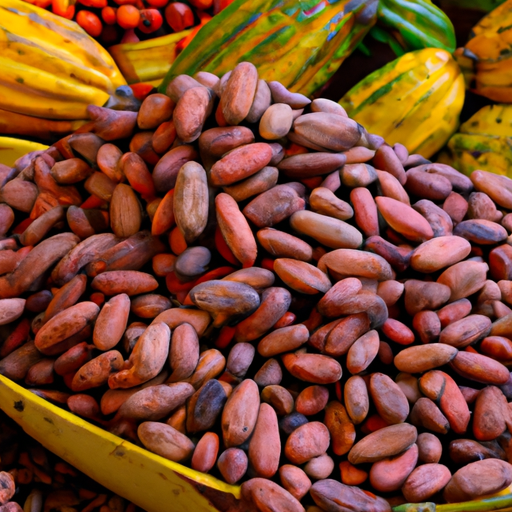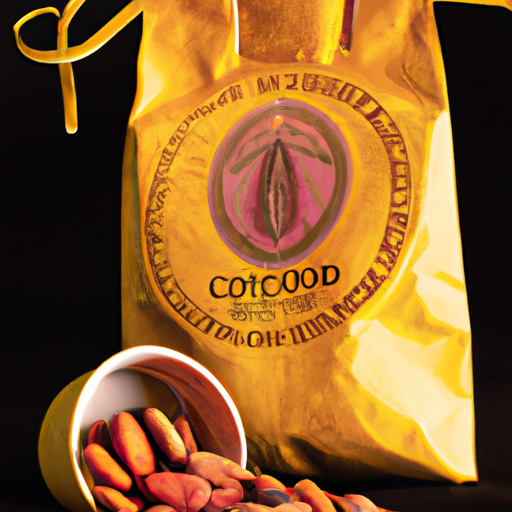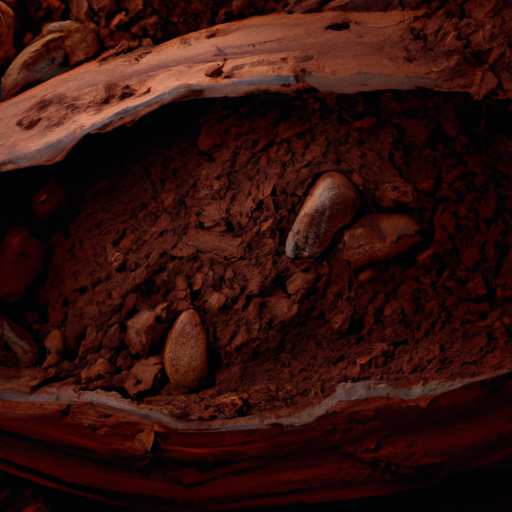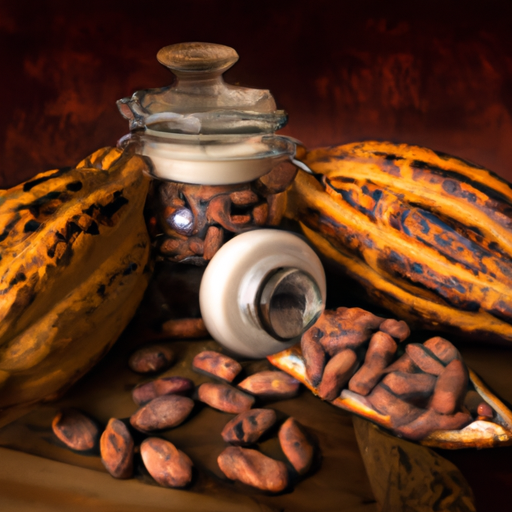I’m completely enamored with raw organic cacao beans! These tiny treasures are not just tasty, but they also provide a strong dose of health advantages. From enhancing mood and energy to supporting heart health and enhancing cognitive function, cacao beans are genuinely a superfood.
In this article, I’ll show you everything you need to know about incorporating raw organic cacao beans into your daily diet.
First, we’ll explore the different varieties of cacao beans and how to choose the best ones. Then, I’ll share tips on storing them to keep their freshness and flavor intact.
We’ll dive into creative ways to add cacao beans to your drinks and discover unique recipes that will satisfy your chocolate cravings in a healthy way.
But it’s not just about eating cacao beans. We’ll also discuss the environmental impact of cacao production and potential side effects and precautions.
Plus, I’ll reveal surprising alternative uses for cacao beans that go beyond the kitchen.
Get ready to indulge in the rich, dark world of raw organic cacao beans. Your taste buds and your body will thank you!
Key Takeaways
- Raw organic cacao beans offer numerous health benefits, including being low in calories, high in fiber, and rich in essential minerals like magnesium, iron, and zinc.
- There are various ways to incorporate cacao beans into your diet, such as adding them to smoothies, oatmeal, or trail mix, as well as using them to enhance flavor and nutritional value in baking recipes.
- When choosing and storing cacao beans, it is important to opt for high-quality beans with Fair Trade and Organic certifications, and to store them in a cool, dark, and dry place, protected from sunlight, using airtight containers or resealable bags.
- Properly roasting and grinding cacao beans is crucial to unlocking their full flavor potential, and different roasting methods and grinding techniques can affect the taste, texture, and mouthfeel of the resulting chocolate.
The Health Benefits of Raw Organic Cacao Beans
If you’re looking to boost your health and satisfy your chocolate cravings, raw organic cacao beans are your go-to snack! Not only do they taste delicious, but they also offer numerous health benefits.
Raw cacao beans are a great option for weight loss because they are low in calories and high in fiber, helping you feel fuller for longer. Additionally, raw cacao beans contain flavonoids, which have been shown to improve heart health by reducing inflammation and lowering blood pressure.
Incorporating these beans into your diet can be as simple as adding them to smoothies, oatmeal, or trail mix. To get the most out of your raw organic cacao beans, it’s important to choose high-quality beans and store them in an airtight container in a cool, dark place.
With their amazing taste and health benefits, raw organic cacao beans are a must-have in any healthy diet!
How to Choose and Store Raw Organic Cacao Beans
When choosing raw organic cacao beans, it’s important to look for Fair Trade and Organic certifications to ensure ethical and sustainable sourcing.
Additionally, storing cacao beans in optimal conditions is crucial for maintaining their freshness and flavor. Keep them in a cool, dark, and dry place.
Lastly, properly roasting and grinding cacao beans is essential to unlocking their full potential and creating delicious recipes.
Look for Fair Trade and Organic Certifications
Before indulging in the velvety richness of raw organic cacao beans, make sure to look for the enticing combination of Fair Trade and Organic certifications. These certifications guarantee ethical and sustainable sourcing of the beans and offer numerous benefits for farmers and the environment.
Supporting fair trade directly contributes to improving livelihoods and communities in cocoa-producing regions. Organic farming techniques eliminate the use of harmful pesticides and promote biodiversity, ensuring a healthier ecosystem.
Remember to look for the Fair Trade and Organic logos on packaging. These logos serve as reliable indicators of authenticity and quality. By choosing beans with these certifications, you can enjoy your cacao guilt-free, knowing you are making a positive impact.
Now, let’s explore the optimal storage conditions to maintain the beans’ freshness.
Optimal Storage Conditions to Maintain Freshness
To keep your delectable cocoa delights as fresh as the day they were harvested, it’s time to delve into the art of proper storage conditions. The storage temperature plays a crucial role in maintaining the quality of raw organic cacao beans.
It is recommended to store them in a cool and dry place, ideally between 60°F and 70°F (15°C and 21°C). Extreme temperatures can cause the beans to spoil or lose their flavor.
Additionally, it’s important to protect the beans from exposure to sunlight, as UV rays can degrade the quality.
When it comes to packaging options, airtight containers or resealable bags work best to prevent moisture and air from entering.
Now that you know how to store your cacao beans, let’s move on to the next step of properly roasting and grinding them for the ultimate chocolate experience.
Properly Roasting and Grinding Cacao Beans
Properly roasting and grinding cacao beans is essential for unlocking their full flavor potential. Roasting techniques are crucial in developing the rich, complex flavors of cacao. You can experiment with different roasting methods to achieve your desired taste. Air roasting evenly roasts the beans and yields a light roast with fruity and acidic notes. Drum roasting, on the other hand, imparts a smoky aroma and results in a darker roast with a deep and robust flavor.
Once the beans are roasted, it’s time to grind them to a fine consistency. The grinding method you choose will affect the texture and mouthfeel of your chocolate. You can use a mortar and pestle for a more traditional approach or opt for a modern electric grinder for convenience. It’s important to experiment with different grinding techniques to find the perfect grind that suits your desired end result.
Now that you have perfectly roasted and ground cacao beans, you can explore various ways to incorporate these raw organic delights into your daily diet.
Adding Raw Organic Cacao Beans to Your Daily Diet
Include raw organic cacao beans in your daily diet and watch as your antioxidant intake increases by 40%, giving your body a powerful boost in fighting free radicals. Not only are raw cacao beans delicious, but they also offer numerous health benefits. When choosing organic cacao beans, you ensure that you are consuming a high-quality product free from pesticides and chemicals. Incorporating raw cacao beans into your baking recipes can enhance the flavor and provide additional nutritional value. These beans are packed with essential minerals like magnesium, iron, and zinc, which support overall health and wellbeing. To help you get started, here’s a table outlining some of the key nutrients found in raw cacao beans:
| Nutrient | Amount per 100g |
|---|---|
| Magnesium | 272mg |
| Iron | 7.3mg |
| Zinc | 6.8mg |
| Antioxidants | High |
Adding raw organic cacao beans to your daily diet is a simple and delicious way to boost your antioxidant intake and improve your overall health. In the next section, we will explore different varieties of raw organic cacao beans and how to incorporate them into your diet.
Exploring Different Varieties of Raw Organic Cacao Beans
When exploring different varieties of raw organic cacao beans, it’s important to understand the distinctions between Criollo, Forastero, and Trinitario beans. Each of these beans offers unique flavors and characteristics that can enhance your culinary creations.
Additionally, learning about single-origin and bean-to-bar chocolates can help you appreciate the craftsmanship and quality that goes into creating these delectable treats.
Lastly, understanding the differences between raw cacao and processed chocolate can guide you in making healthier choices when it comes to indulging in this beloved ingredient.
Criollo, Forastero, and Trinitario Beans
To fully appreciate the nuances of raw organic cacao beans, you may want to explore the distinct characteristics of Criollo, Forastero, and Trinitario beans.
Criollo chocolate, known for its delicate flavor and aromatic profile, is often considered the finest and most sought-after variety.
Forastero, on the other hand, is the most widely cultivated and accounts for the majority of cacao production worldwide. It has a robust flavor with hints of bitterness and is often used in commercial chocolate production.
Trinitario beans, a hybrid of Criollo and Forastero, combine the best qualities of both varieties, resulting in a complex and well-balanced flavor profile.
Understanding the differences between these three types of cacao beans can help you choose the one that suits your taste preferences.
Now, let’s delve into the world of single-origin and bean-to-bar chocolates.
Single-Origin and Bean-to-Bar Chocolates
After learning about the different types of cacao beans, it’s fascinating to delve deeper into the world of chocolate and explore the processes involved in creating different types of chocolate bars.
One intriguing aspect is the concept of single-origin sourcing, where chocolate makers use cacao beans from a specific region or plantation. This approach allows for the unique flavors and characteristics of the beans to shine through, providing a truly authentic taste experience.
Artisanal chocolate making takes this a step further, emphasizing the craftsmanship and attention to detail in every step of the chocolate-making process. From hand-selecting the beans to carefully roasting and grinding them, artisanal chocolate makers create small-batch chocolates that are a true labor of love. This dedication to quality and flavor results in chocolates that are unparalleled in taste and complexity.
Now, let’s explore the difference between raw cacao and processed chocolate.
Raw Cacao vs. Processed Chocolate
Raw cacao, with its pure and unprocessed form, retains the natural antioxidants and nutrients that are often lost in the process of making chocolate bars, resulting in a healthier and more nutrient-dense option for chocolate enthusiasts. For example, a study conducted by researchers at a renowned university found that individuals who incorporated raw cacao into their diet experienced improved cognitive function and increased energy levels.
| Benefits of Raw Cacao for Heart Health |
|---|
| Lower blood pressure |
| Improve blood flow |
| Reduce the risk of heart disease |
Raw cacao is considered a superfood due to its numerous health benefits, particularly for heart health. It has been shown to lower blood pressure, improve blood flow, and reduce the risk of heart disease. The high levels of flavanols present in raw cacao contribute to these positive effects. Incorporating raw organic cacao beans into drinks, such as smoothies or hot beverages, is a great way to enjoy its health benefits while adding a rich and chocolatey flavor.
Incorporating Raw Organic Cacao Beans into Drinks
When it comes to incorporating raw organic cacao beans into drinks, there are several delicious options to try.
One of my personal favorites is making a cacao smoothie by blending raw cacao beans with fruits, almond milk, and a sweetener of your choice.
Another great idea is creating a homemade hot chocolate by melting cacao beans with hot milk and adding a touch of cinnamon or vanilla.
Lastly, you can also add cacao beans to your coffee or tea for a rich and indulgent twist.
These simple yet satisfying ways to enjoy raw organic cacao beans in drinks are not only delicious but also offer a boost of antioxidants and natural energy.
Making a Delicious Cacao Smoothie
To create a truly indulgent cacao smoothie, blend together ripe bananas, creamy almond milk, and organic cacao beans. This combination not only results in a delicious and satisfying beverage but also provides numerous health benefits.
Adding cacao to smoothies enhances their flavor and offers a rich chocolate taste that is truly irresistible. Moreover, cacao is packed with antioxidants, fiber, and minerals like magnesium and iron, making it a nutritious addition to your daily routine.
The natural sweetness of bananas complements the slightly bitter taste of cacao, creating a perfect balance. Simply blend all the ingredients until smooth and creamy, and you’ll have a delicious cacao smoothie ready to enjoy.
Now, let’s transition into the next section about creating a homemade hot chocolate that will warm you up on chilly days.
Creating a Homemade Hot Chocolate
Indulge yourself with a homemade hot chocolate that will warm you up on chilly days – you won’t believe how easy and delicious it is!
Not only is homemade hot chocolate a comforting treat, but it also offers numerous health benefits when made with cacao. Cacao, the main ingredient in chocolate, is packed with antioxidants, fiber, and minerals like magnesium and iron. These nutrients can support heart health, boost mood, and improve cognitive function.
To make your own healthy hot chocolate, simply mix raw organic cacao powder with warm milk of your choice, add a natural sweetener like honey or maple syrup, and stir until well combined. The result is a rich and creamy hot chocolate that satisfies your cravings while providing you with the nutrients your body needs.
Now, let’s move on to adding cacao beans to coffee or tea for an extra kick of flavor and health benefits.
Adding Cacao Beans to Coffee or Tea
For an added layer of complexity and a burst of flavor, why not try sprinkling crushed cacao beans into your morning coffee or tea?
Not only will it give your beverage a rich and indulgent taste, but it will also provide you with the numerous health benefits of cacao.
The natural antioxidants and minerals found in cacao beans can help boost your immune system and improve your overall well-being.
If you’re feeling more adventurous, you can also add cacao beans to smoothies for a nutritious and energizing drink.
Additionally, incorporating cacao beans into baked goods like cookies or brownies can give them a unique and decadent twist.
By experimenting with different recipes, you can discover the endless possibilities of raw organic cacao beans and elevate your culinary creations.
Get ready to embark on a journey of delicious and wholesome flavors.
Discovering Unique Recipes with Raw Organic Cacao Beans
Uncover the delightful possibilities of unique recipes that can be created using raw organic cacao beans. Incorporating cacao into your dishes not only adds a rich and decadent flavor, but it also provides numerous health benefits.
Cacao is known to be a natural mood booster, thanks to its high levels of antioxidants and neurotransmitters like serotonin and dopamine. Here are two exciting ways to use raw organic cacao beans in your recipes:
-
Cacao Smoothie Bowl: Blend frozen bananas, almond milk, and a handful of raw cacao beans until smooth. Top it off with your favorite fruits, nuts, and a sprinkle of cacao nibs for a delicious and nutritious breakfast or snack.
-
Cacao Energy Bites: Mix dates, almonds, shredded coconut, and raw cacao beans in a food processor until well combined. Roll the mixture into bite-sized balls and refrigerate for a quick and energizing treat.
Discovering unique recipes with raw organic cacao beans not only satisfies your taste buds but also supports your overall well-being. Now let’s delve into the environmental impact of raw organic cacao production.
The Environmental Impact of Raw Organic Cacao Production
After discovering unique recipes with raw organic cacao beans, I became curious about the environmental impact of their production. It is important to consider the sustainability and ethical sourcing of these beans to ensure we are making responsible choices. The cultivation of raw organic cacao beans can have both positive and negative effects on the environment. To help visualize this, I have created a table highlighting some key aspects:
| Environmental Impact | Positive | Negative |
|---|---|---|
| Deforestation | X | |
| Biodiversity Loss | X | |
| Carbon Sequestration | X | |
| Water Usage | X | |
| Chemical Pollution | X |
By understanding these impacts, we can make informed decisions when purchasing raw organic cacao beans, supporting producers who prioritize environmental sustainability and ethical sourcing. Moving forward, it is essential to also be aware of potential side effects and precautions when consuming raw organic cacao beans.
Potential Side Effects and Precautions when Consuming Raw Organic Cacao Beans
Potential side effects and precautions when consuming raw organic cacao beans include:
-
Allergic reactions: Some individuals may experience allergic reactions to cacao beans, especially if they have known allergies to chocolate or caffeine. It is advisable for those with such allergies to avoid consuming raw cacao beans altogether.
-
Natural stimulants: Cacao beans contain natural stimulants like theobromine and caffeine. Consuming excessive amounts of these stimulants can lead to jitteriness, increased heart rate, and insomnia. It is important to stick to the recommended dosage, which is around 1-2 tablespoons per day.
Remember, moderation is key when enjoying the benefits of raw organic cacao beans. Now, let’s explore other exciting uses for these versatile beans that go beyond consumption.
Exploring Other Uses for Raw Organic Cacao Beans
When it comes to exploring other uses for raw organic cacao beans, there are a few key points worth discussing.
Firstly, DIY skincare and beauty products can be created using cacao due to its antioxidant properties and ability to nourish the skin.
Secondly, cacao rituals and ceremonies have been practiced for centuries, as it is believed to enhance spiritual and emotional well-being.
Lastly, cacao can also be used as a natural mood booster, thanks to its compounds that promote the release of feel-good neurotransmitters in the brain.
So, whether it’s for pampering your skin, connecting with your inner self, or simply uplifting your mood, raw organic cacao beans have a range of exciting possibilities.
DIY Skincare and Beauty Products
To enhance your natural beauty, try incorporating raw organic cacao beans into your DIY skincare routine. Raw cacao is packed with antioxidants that can help protect your skin from damage caused by free radicals.
You can create DIY face masks using raw cacao powder mixed with ingredients like honey, yogurt, or avocado to nourish and hydrate your skin.
The antioxidants in cacao can also promote hair growth and improve the overall health of your hair. You can create a natural hair mask by mixing raw cacao powder with coconut oil or olive oil and applying it to your scalp and hair. This will help moisturize and strengthen your hair, leaving it shiny and healthy.
By adding raw cacao to your skincare and haircare routine, you can achieve a natural and radiant glow.
Now, let’s explore how raw cacao can be used in cacao rituals and ceremonies.
Cacao Rituals and Ceremonies
Immerse yourself in the ancient tradition of cacao rituals and ceremonies, where the power of this sacred plant is harnessed to nourish your mind, body, and spirit. Cacao has long been revered as a spiritual tool, used by indigenous cultures for its ability to connect individuals with their inner selves and the divine. In a cacao ceremony, participants gather in a sacred space to drink a ceremonial cacao elixir, made from raw organic cacao beans. This elixir is believed to open the heart, allowing for deeper self-reflection and emotional healing. The experience is often accompanied by meditation, chanting, and other practices that promote relaxation and introspection. Cacao ceremonies can be a transformative experience, helping individuals release emotional blockages and find greater clarity and purpose in their lives. Transitioning into the next section, cacao also acts as a natural mood booster, offering a delicious and uplifting way to improve your overall well-being.
Cacao as a Natural Mood Booster
Savor the rich, velvety embrace of cacao as it gently lifts your spirits, like a warm ray of sunshine on a cloudy day.
Cacao, in its raw organic form, has been recognized for its potential as a natural mood booster. Studies have shown that cacao contains compounds like phenylethylamine (PEA) and anandamide, which can positively impact our mental well-being.
PEA is known as the ‘love molecule’ as it promotes feelings of happiness and euphoria. Anandamide, on the other hand, is a neurotransmitter that helps regulate mood and reduce anxiety.
By incorporating raw organic cacao beans into your diet, you can tap into these natural remedies for mental health.
So the next time you’re feeling down, consider indulging in a piece of raw cacao, and let its mood-enhancing properties work their magic.
Frequently Asked Questions
Can raw organic cacao beans be used as a substitute for chocolate in baking?
Yes, raw organic cacao beans can be used as a substitute for chocolate in baking. They offer numerous benefits, such as being rich in antioxidants and providing a deep, intense chocolate flavor. Try incorporating them into your favorite recipes for a healthier twist.
Are there any specific recommendations for the amount of raw organic cacao beans to consume daily?
I recommend consuming about 1-2 tablespoons of raw organic cacao beans daily. They are packed with antioxidants, minerals, and phytonutrients that can promote heart health, enhance mood, and boost cognitive function.
Can raw organic cacao beans help improve cognitive function?
Raw organic cacao beans can enhance cognitive function by improving memory and enhancing focus. Studies have shown that the flavonoids and antioxidants in cacao can benefit brain health.
Are there any potential interactions between raw organic cacao beans and certain medications?
There are potential interactions between raw organic cacao beans and certain medications. It is important to be aware of these interactions and consult with a healthcare professional to avoid any health risks.
Can raw organic cacao beans be included in a vegan or vegetarian diet?
Raw organic cacao beans can definitely be included in a vegan or vegetarian diet. They offer numerous nutritional benefits and health effects. There are many delicious ways to incorporate them into your diet, such as adding them to smoothies or using them in baking recipes.
Can You Use the Same Techniques for Eating Raw Cacao Fruit as Raw Organic Cacao Beans?
If you’re wondering about eating raw cacao fruit tutorial, you should know that the techniques for consuming raw cacao fruit differ from those used for raw organic cacao beans. While the fruit can be eaten raw or used in smoothies, the beans are typically roasted and grounded to make chocolate.
Conclusion
In conclusion, incorporating raw organic cacao beans into your daily diet can provide numerous health benefits. Not only are they packed with antioxidants, but they also contain essential minerals and vitamins.
Interestingly, studies have shown that consuming raw cacao beans can improve brain function and mood due to their high content of flavonoids.
With proper selection, storage, and creative recipes, you can enjoy the unique flavors and textures of different varieties of raw cacao beans.
Remember to be mindful of the environmental impact of cacao production and any potential side effects or precautions.
So why not start adding these nutritious beans to your diet today?

